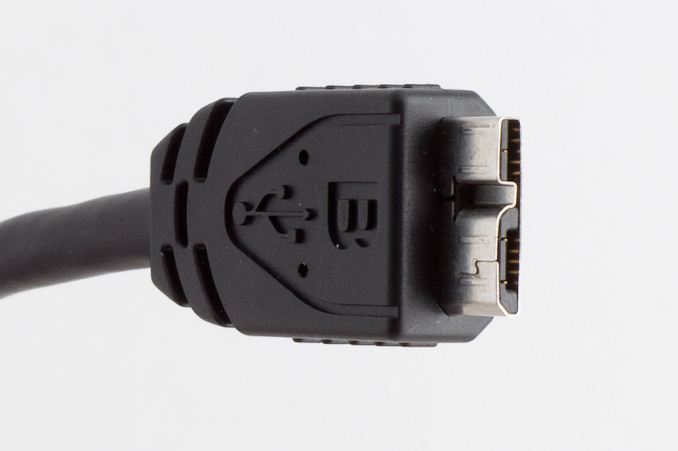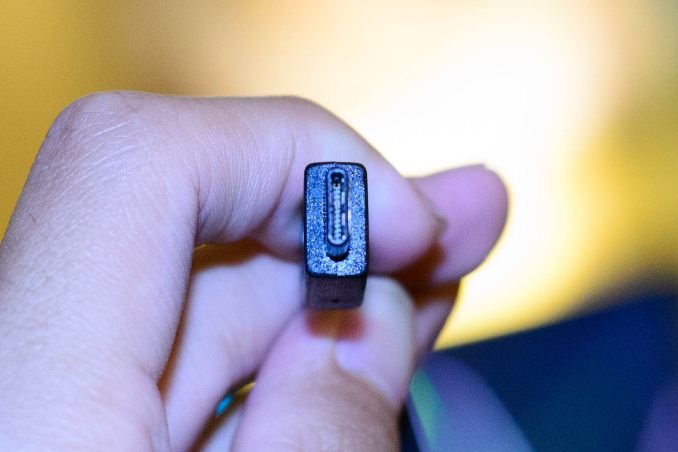USB Power Delivery v2.0 Specification Finalized - USB Gains Alternate Modes
by Brett Howse on September 17, 2014 8:00 AM EST
The last while has been a busy time for the USB 3.0 Promoters Group, with the new USB 3.1 Type-C Connector detailed last month. Joshua was able to get a hands on with the new connector at IDF last week. With support for up to 10 Gbps, a new reversible Type-C connector, and up to 100 watts of power delivery, the USB group is trying to expand the already universal connector to be able to do much more than is possible with the current specification. To fulfill this mandate, they have now finalized the USB Power Delivery v2.0 spec, and the Billboard Device Class v1.0 spec.
When USB was first introduced, the thought was that it would be primarily a data interface, with a limited amount of power delivery which was generally used to power the electronics of certain devices. The initial specification for USB only had provisions for 0.75 watts of power – 150 mA at 5 V. USB 2.0 bumped that to 500 mA, or 2.5 watts, and USB 3.0 specified 900 mA at 5 V, or 4.5 watts. All of these specifications allow for power as well as data transmission at the same time. In addition, there was also a Battery Charging specification which allows up to 1.5 A at 5 V for a maximum of 7.5 watts of power but with no data transmission available. The jump from 7.5 watts to 100 watts of the new specification is a huge increase, and one that cannot be done with just an amperage increase on the system as was done in the previous versions of USB. Version 3.1 now supports 5 V, 12 V, and 20 V on the pins to allow the higher power output without excessive current, but even the current has been increased to a maximum of 5 A which is much higher than before.
 The inelegant USB 3.0 Micro-B connector
The inelegant USB 3.0 Micro-B connector
USB Power Delivery is designed to increase the flexibility of USB, by providing enough power for many more devices, while at the same time still allowing data delivery. It is also even more flexible, due to a couple of changes. First, the direction of power delivery is no longer fixed. Imagine a tablet with a keyboard attached. The keyboard can have a battery, and the battery can be charged through the data connection, but when the tablet is unplugged from its charger, the power flow can reverse and the tablet can now be powered by the keyboard. Another example is a laptop with six USB ports. The USB ports can be used for peripherals, or, a USB charger can be connected to any port to charge the laptop. Dedicated charging connectors will no longer be required.
 The reversible USB 3.1 Type-C connector
The reversible USB 3.1 Type-C connector
Another change is that all devices must now negotiate the amount of power required, and that can be renegotiated if another devices requires additional power. A good scenario would be if you have a laptop, and you are charging your phone on one of the USB ports. The phone would be pulling the maximum amount of power it can in order to charge quickly. If you then plug in a USB RAID array, it will need additional power at the start in order to get all of the disks spinning, but then can be lowered to a steady state. The system can lower the power delivery to the phone, provide it to the RAID array, and then move it back to the phone when the power is available.
The final key is that the Power Delivery specification is not just for power, nor is it just for USB. The Power Delivery Specification allows Alternate Modes to be defined, and the system can negotiate to enable these modes, enter them, and exit them. These modes will be defined outside the scope of USB-IF specifications using Structured Vendor Defined Messages. This allows the ability to reconfigure some of the pins a USB Type-C connector exposes and will allow the cable to be used for many different purposes rather than just for USB.
This leads us to the second specification – the Billboard Device Class. This specification outlines the methods used to communicate the Alternate Modes supported by the Device Container to a host system. It includes descriptors which can be used to provide support details in a human-readable format. What it does not contain is the methodology to switch to the Alternate Mode – that is done in the Power Delivery specification itself. The Billboard Device Class will allow a device which supports an Alternate Mode to connect to a host which does not support that mode, and then inform the user why it does not work without having silent failures, and for this reason all Billboard Devices must support USB 2.0 as a minimum.
This new framework could open the ubiquitous USB cable up to an entirely new array of devices and functions. One possibility that the USB-IF mentions in the specification is a theoretical means for PCI-E over USB. I’ve already given the example of a tablet with a battery in the keyboard, but a laptop could be connected to a monitor which can also charge the laptop. Much more power hungry devices can be connected to a USB port as well, including printers and high speed storage. All of this was defined with a graceful fail as well, so the user is not stuck wondering why his device is not functioning any longer.
The new Alternate Modes have quite a potential, and with the increased power capabilities of USB 3.1 and the Power Delivery Specification, it will be very interesting to see how these capabilities are taken advantage of in future devices.
Source: USB-IF












46 Comments
View All Comments
darth415 - Wednesday, September 17, 2014 - link
microUSB is designed to break off as well without damaging the socket. I'm sure Type-C maintains this functionality. It is an official feature of microUSB, and 3 of my broken cable ends over the last couple of years from dropping my phone can attest to that.psychobriggsy - Wednesday, September 17, 2014 - link
Meh, I noticed a broken micro-usb tongue in my tablet last night so it clearly isn't that well implemented a feature ... however I think USB3.1 has a thicker tongue design due to being in the centre.I notice that over the years, the simple cheap 4-pin USB plug has now evolved into a 24-pin connector.
phoenix_rizzen - Wednesday, September 17, 2014 - link
I've broken off the "tongue" connector that's inside the USB slot on several desktop systems. Replacing a single USB port on a desktop is not easy.I've also broken off the "tongue" connector that's inside the micro-USB slot on a smartphone. Luckily, that was covered under warranty. There's no way to replace that manually (at least, not without a lot of specialised tools, a lot of time, a nice clean, level workspace, a steady hand, etc, etc, etc).
And several friends have also broken off the "tongue" connector inside the micro-USB slot on several devices (smartphones and tablets).
Between us, we've only had 2 USB cables fail in over a decade of use.
The "tongue" connector in USB is it's stupidest feature.
fokka - Wednesday, September 17, 2014 - link
you're right, but when you look at micro usb you can see a similar tongue as in the type c connector. i'm sure there are people who managed to break off the tongue in a micro usb socket, but i don't have the feeling that it's a widespread problem.that said, i would still have a better feeling with a more robust looking lightning-style connector, but let's just get our hands on some devices with type c until we make a final judgement.
repoman27 - Wednesday, September 17, 2014 - link
It really should be noted that both the the Type-C Cable and Connector and the Power Delivery 2.0 Specs are entirely separate from the USB 3.1 Spec. In other words you do not need USB 3.1 SuperSpeed Plus or USB 3.0 SuperSpeed to implement either of them. You can have a USB 2.0 device that uses Type-C connectors and is capable of various PD 2.0 modes. There seems to be a ton of confusion on the interwebs about this. Mobile devices could start using the Type-C connector six months from now despite the fact that most of them won't even support USB 3.0 SuperSpeed.Also, I'm highly doubtful that all ports will be created equal when it comes to USB PD 2.0 and battery charging. Motherboards with 14 USB ports probably won't route 100 W to each of them. And, as has already been pointed out, to supply 100 W to a single port requires at least one of the devices to have a PSU with 100 W to spare. Thus a laptop may have ports that are capable of charging it, but it will never be able to supply more than say 5 V @ 2 A (10 W, Profile 1) or 12 V @ 3 A (36 W, Profile 3). So unless the new paradigm is 7-port desktop USB hubs with 750 W PSU's, we're still not going to be able to depend on a USB port being able to power or charge a given device unless they're expressly designed to work together.
repoman27 - Wednesday, September 17, 2014 - link
Have we seen any USB Power Delivery capable devices yet? The PD 1.0 spec was released over 2 years ago, and 1.2 came out last June. Is 2.0 going to magically gain traction where 1.x wasn't able to?markass530 - Monday, September 22, 2014 - link
That stuff is proprietary , not a USB standardmarkass530 - Monday, September 22, 2014 - link
nevermindMikeMurphy - Wednesday, September 17, 2014 - link
Somewhat like present USB, dedicated chargers work best while standard ports will also do the job, but slower. Consumers already manage this.repoman27 - Wednesday, September 17, 2014 - link
There's a difference between battery charging where lower power means slower charging and power delivery where a device needs a certain amount of juice to operate at all though.